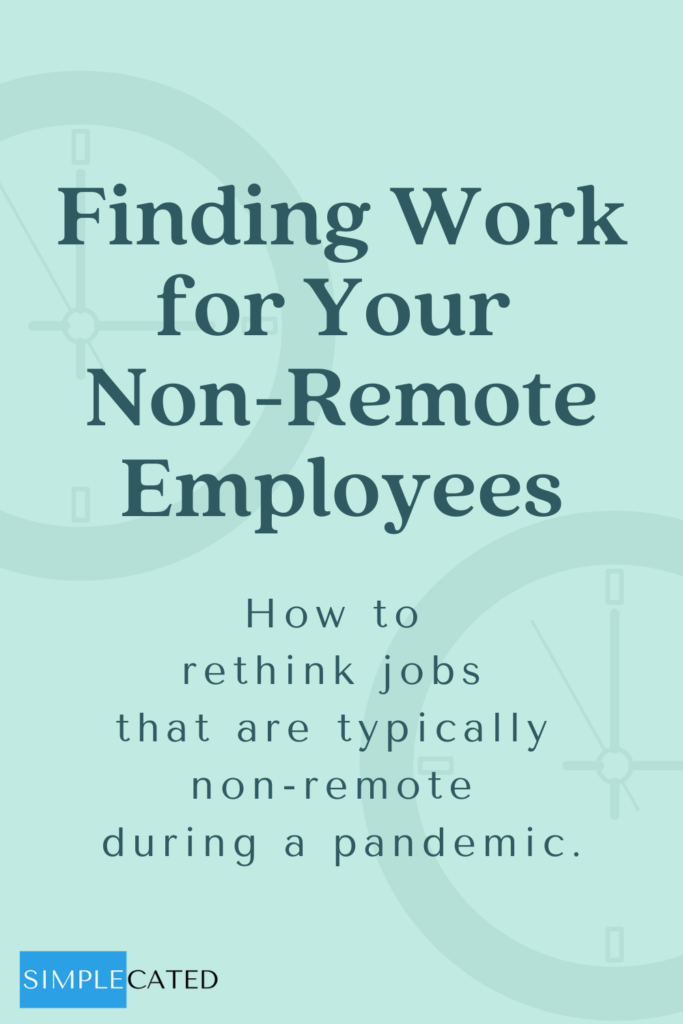As the weeks of business closures have turned into months, many employees haven’t been able to work because their jobs aren’t designed to be remote. With restaurants, retail stores, child care businesses, hotels, and a number of other industries, many of their employees are in jobs that are designed to be done onsite. According to a recent Time article, millions of Americans are in jobs that typically can’t be done remotely.
Some businesses are starting to reopen, but many haven’t yet. While trying to stop the spread of COVID-19, businesses still need revenue, and employees still need income. As a leader, you’re trying to figure out ways to keep your business operating in some way – any way. This is a great opportunity to rethink some of these jobs. If you’re able to find ways for your employees to continue working in some capacity, you’ll be able to bring in revenue and help your business’s financial stability, plus, you’ll be helping your employees receive income and avoid being laid off. As an added perk, you’ll be providing a service to your community.
Even if you’re continuing to pay your employees or have received a loan through the CARES Act Payroll Protection Program, it’s still ideal to have your employees doing at least some work if you’re paying them. As you consider various options, you’ll certainly need to prioritize the health and safety of your employees and customers and make sure you follow any government and CDC regulations.
How can we rethink these jobs in ways that help benefit everyone – maybe even strengthening your business?
Study the job description. As you read through the job description, really think through each element. Which items might not depend on a particular location? You’ll want to avoid thinking about “how it’s always been done.” This is about identifying opportunities. For example, if you’re an associate at a retail store, the task of re-stocking your area really depends on you being at that location. The task of explaining products to customers, however, could potentially be done elsewhere, so this could be an opportunity to provide an enhanced customer service experience to your online shoppers, connect with current customers, etc.
Determine what your customers need. Think about those who frequent your business. What do you provide to them? Why do they come to you specifically rather than one of your competitors? Consider the tangible elements (like a physical product) as well as non-tangibles (like to feel happy or comforted). How could you continue to meet their needs?
Involve others in brainstorming and in any decisions. This is new territory for everyone. Make sure your leadership is onboard, and involve other leaders so you can build ideas together and ensure consistent application of this mindset throughout your business. Be sure to involve your employees in coming up with ideas as well. They have a personal stake in this too, and they may have some really creative suggestions. This can help you determine meaningful options, identify potential roadblocks, and keep them involved in decisions that affect them. As you make decisions, the more communication the better. Communicate what work you will be providing along with your rationale. Also include if you determined that any suggested ideas would not work. As your plans go into action, keep the lines of communication open so you can determine what works well and what needs to change.
Consider temporary reassignments. Maybe your business has a need for additional staff in other areas. Consider offering temporary reassignments to those highly-needed jobs. This will enable you to meet the staffing need much more quickly than if you hired externally, plus, retaining your current employees means you’ll avoid the cost of refilling their vacancies later. Keep in mind any collective bargaining agreements or predictive scheduling laws that may apply. You’ll also want to adjust the pay as needed if the new job is in a higher pay grade or has a different exemption status than the current job.
Keep in mind the FLSA status. Remember that you’ll need to make sure to track the hours of hourly employees to ensure you pay them correctly. This is the case even if they’re only working a small portion of the full, regular schedule you’re continuing to pay them for. You want to have accurate records of hours worked so you can document that you paid them correctly for any time worked in case any questions or disputes arise later on. If you’ll be providing remote work and have time management software available, you may want to test its capabilities to see if it can handle the number of employees who will now be using it. Otherwise, decide on a consistent method of time reporting, and require it of your employees.
Prepare for refusals to work. Employees could have special circumstances that need to be taken into consideration such as being ill, caring for children, or having an ADA accommodation request. Outside of this, you could have employees refuse to work, so be prepared to respond consistently. For those who are afraid of coming onsite, assure them of all the preparations you’re making for their health and safety. If you’ve been paying all of your employees their regular rate of pay while not working, consider adjusting that now so there is motivation to return to work. If they refuse because they’re receiving more in unemployment benefits, remind them that you’ll be notifying the state that work is now available for them, so it could affect their eligibility. (You should also consider whether you’re providing the appropriate wages for your workers.)
Whatever decisions you make will have a huge impact on your employees – either positively or negatively. This is an opportunity for you to demonstrate your desire to do everything you can to support them and hopefully help them avoid being laid off. Just because a job isn’t originally designed to be remote doesn’t mean there aren’t ways to reimagine how the job works. Whether you offer the option to work remotely or for onsite work, you’ll be helping your business and your employees. If you choose to offer remote work, it doesn’t have to be as scary as it may sound! Here are some tips on managing remote performance and keeping remote employees engaged.
Photo credit: By undefined undefined / Canva





